Ripley Entertainment Inc.'s Blog, page 273
May 17, 2019
Health Officials Warn Against The Cow Kiss Challenge
Featured in Ripley's Believe It or Not!

[May 12-18th, 2019] Kissing cows, an expensive typo, flying piranhas, and the rest of the week’s weird news from Ripley’s Believe It or Not!
Cow Kissing Challenge
A bizarre social media challenge sparked by the app Castl has swept through Austria, daring people to kiss cows. Health experts and farmers, however, are worried people could be hurt by irate cows. Castl started the trend to try and raise money for charity, even being as lenient to allow people to kiss, “with or without tongue.”
2.3 Billion Dollar Typo
Australia recently changed their $50 bill. It still features Australia’s first female member of parliament, Edith Cowan, but new features added security and design changes. Accompanying her portrait is a quote reading, “It is a great responsibility to be the only woman here.” Unfortunately, they misspelled responsibility, leaving out the last “i.” They promise to correct their mistake but didn’t catch the error until after the bill was printed 46 million times.

Flying Piranhas
A Peruvian man was stopped by United States Customs officers after they found 40 piranhas in his luggage. The man was a chef, and promised the fish posed no danger, and that he was planning to cook them. After verifying his story and realizing the fish had been vacuum-sealed and frozen, they let him through.

The Deepest Dive
Explorer and businessman Victor Vescovo descended to the deepest part of the Mariana Trench, landing deeper than Don Walsh, James Piccard, and James Cameron. At 35,853 feet below the surface of the Pacific Ocean, the pressure was roughly 1,000 times more than the pressure at sea level. He observed bacterial mats and small arthropods at the world’s deepest point but also recorded seeing a plastic bag and candy bar wrapper.
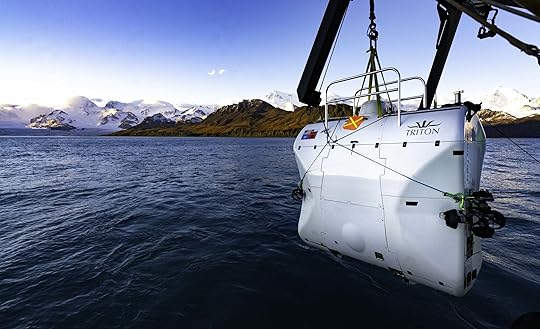
CC Richard Varcoe on behalf of Caladan Oceanic LLC
Elite Nomad Skeletons
A Russian farmer uncovered the remains of at least three nomadic tribesmen who roamed the plains northwest of the Caspian Sea. Along with the skeletons, which appeared to have been buried in wooden coffins, archaeologists uncovered a horse wearing a harness. The skeletons are believed to have once belonged to elite hunters because of the weapons, gold, jewelry, and bronze cauldron recovered from the site.
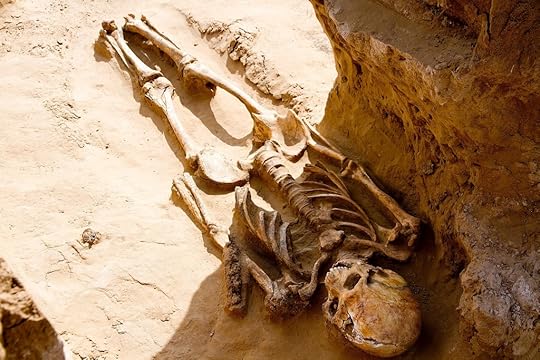
Credit: Ministry of Culture and Tourism of the Astrakhan Region
Source: Health Officials Warn Against The Cow Kiss Challenge
The Fish That Gets Eye Lifts, Chin Jobs, And Other Cosmetic Surgeries
Featured in Ripley's Believe It or Not!

Those skilled with the scalpel have no shortage of customers in Southeast Asia who seek cosmetic surgeries for their pet fish. Common procedures include facelifts, eye lifts, and chin jobs.
The Asian arowana is a highly prized (and sometimes very expensive) aquarium fish that is particularly popular among wealthy Chinese businessmen. Young fish can be acquired for as little as $1,000, but a member of the Chinese Communist Party allegedly purchased one of the more mature specimens for $300,000. They are said to live for decades.

The arowana, also known as the dragon fish (or lóng yú in Chinese), has large, glimmering scales in red, gold or green and two whiskers below its mouth. The fish can grow as large as three feet long. It’s believed they bring good luck and prosperity to their owners, and legend has it that loyal arowana will jump out of their tanks in order to warn their owners about bad business deals.
It’s no wonder they are highly valued among the elite.
Yet, like humans, the arowana occasionally experience the telltale signs of aging and other cosmetic issues. Fortunately for their owners, these problems can easily be remedied through surgical procedures.
A man named Willie Si is known as “Dr. Arowana” in Singapore (his book, Arowana: A Layman’s Guide, is available on Amazon, and according to one consumer is “a must for any Arowana lovers!”). Considered the father of fish plastic surgery, the car-mechanic-turned-fish-consultant began repairing arowana abnormalities in the ’90s. He initially just clipped their tails so they resembled chrysanthemums. He later transitioned to other surgeries, such as removing eyeball fungus with diamond-cutting tools. Si hung up his scalpel after too many botched procedures and now simply doles out comfort and advice to concerned arowana owners.

Eugene Ng is another Singaporean fish doctor who specializes in arowana cosmetic surgery, which is relatively inexpensive considering the cost of the fish itself. He charges $90 for an eyelift and $60 for a chin job (don’t worry, the fish are administered a sedative beforehand). To repair droopy eyes, for example, he loosens the surrounding tissue and pushes the eyeball back into the socket with forceps (see a video of this type of procedure here). Other surgeries involve smoothing out the scales or repairing a swim bladder. Typically, the procedures take less than an hour.
The fish owners strive to make their arowana as perfect as possible. An ideal arowana has straight whiskers, bright and clear eyes, healthy round fins and shiny scales. It must swim with confidence and be neither too thin nor too fat.

Americans also pay to have their pets cosmetically altered, but the patients tend to be canines, not fish. One semi-popular procedure for neutered male dogs is testicular implants, which are called Neuticles. Gregg Miller, the man behind the fake dog balls, says he’s sold over half a million Neuticles over the past two decades. They cost about $310 a pair and are available in 11 different sizes. Why does a dog need a set of phony testicles? To feel whole again. Miller has even created a pair for an elephant.
Typically, dog plastic surgery in the United States is performed for medical, not cosmetic, reasons. Dogs with pushed-in faces such as French bulldogs and pugs sometimes require eyelid lifts and nostril procedures to help them see and breathe better, while shar-pei may need tummy tucks to prevent bacterial infections.
In 2011, U.S. dog owners spent $62 million on plastic surgery for their animals, according to Petplan.
By Noelle Talmon, contributor for Ripleys.com
Source: The Fish That Gets Eye Lifts, Chin Jobs, And Other Cosmetic Surgeries
CARTOON 05-17-2019
May 16, 2019
Wait, There Are Vegetarian Piranhas?
Featured in Ripley's Believe It or Not!

Marine biologists estimate it would take a school of 300 piranhas just five short minutes to completely devour a 180-pound human. With their razor-sharp teeth and their lust for blood, piranhas have earned a reputation as violent flesh eaters, but some varieties are vegetarians.
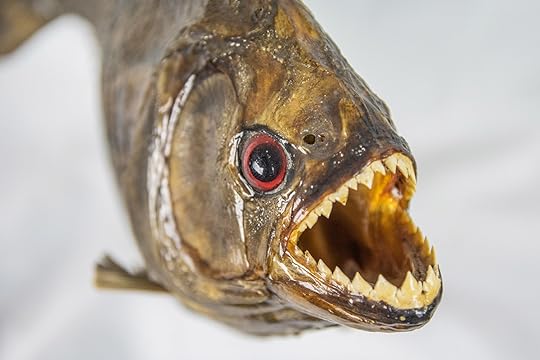
Taxidermy piranha from the Ripley Collection.
It’s estimated that there are around 30 different species of the South American freshwater fish. The Tometes camunani that lives in the Amazon River in Pará, Brazil, only eats river weeds. And some varieties prefer seeds to meat. Other piranhas typically consume shrimp, worms, carrion, and other fish. One staple that’s generally not on their menu? Humans.
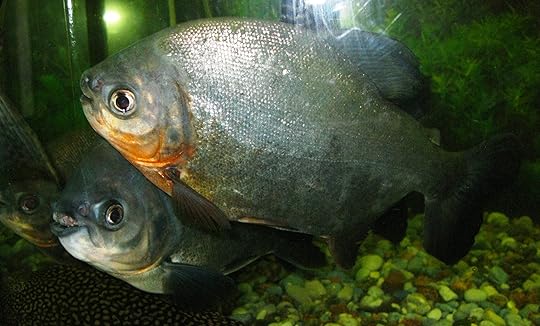
The plant-eating piranha./CC Shatillo G.V.
The Piranha with Human-Like Teeth
In 2016, several specimens of red-bellied pacus—Piaractus brachypomus, a relative of the piranha—were discovered in Lake St. Clair and Port Huron in southeastern Michigan. These “vegetarian piranhas” are known for their square teeth that look suspiciously human. They use their choppers to crush seeds and nuts. Some even have the ability to remove nuts from their shells before eating them.
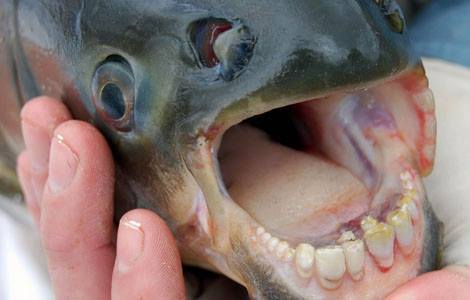
CC Nisamanee Wanmoon
Piranha found outside of South America are usually pets released into the waterways. Twenty-five U.S. states prohibit the transport, purchase, possession or sale of piranhas due to their dangerous characteristics. In 2014, a New York City man was arrested for smuggling nearly 40,000 piranhas, worth $37,376, into the city.
The red-bellied piranha (Pygocentrus natterei) is the most commonly known carnivorous species. It is aggressive, but not as dangerous as many believe. They typically live in large shoals consisting of several hundred fish—sounds terrifying, right? But this is for protection, not hunting. Only when they are starving and food is scarce do they attack large prey, which is usually dead—or nearly so. When hungry, they can devour the flesh of an animal in just minutes.
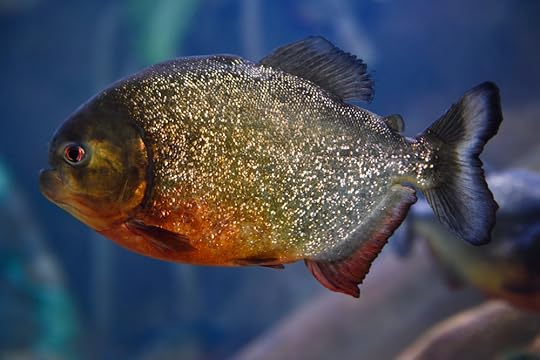
A carnivorous red-bellied piranha at Ripley’s Aquarium of Canada/Reimar, Shutterstock
The Piranha That Makes Barking Sounds
Weirdly, red-bellied piranhas make three different types of sounds, including one that resembles a dog’s bark. When they are in a confrontation with another fish, their quick calls sound similar to a barking canine. Other vocalizations include grunting and gnashing their teeth.
The piranha’s threatening reputation is partially due to President Theodore Roosevelt. In 1913-14, he traveled through the Amazon basin with famous Brazilian explorer Cândido Rondon and noted in his book, Through the Brazilian Wilderness, that the piranha was the “most ferocious fish in the world.”
“The piranhas habitually attack things much larger than themselves,” Roosevelt wrote. “They will snap a finger off a hand incautiously trailed in the water; they mutilate swimmers—in every river town in Paraguay there are men who have been thus mutilated; they will rend and devour alive any wounded man or beast; for blood in the water excites them to madness. They will tear wounded wild fowl to pieces, and bite off the tails of big fish as they grow exhausted when fighting after being hooked.”

It has since been revealed that the Brazilians put on a display to entertain tourists, such as Roosevelt. They orchestrated a feeding frenzy by keeping captive piranha hungry for days.
In general, if humans leave them alone, they are unlikely to attack. Still, piranhas can detect a drop of blood in 200 liters of water, so it’s inadvisable to take a dip in the Amazon if you’re bleeding profusely.
By Noelle Talmon, contributor for Ripleys.com
CARTOON 05-16-2019
May 15, 2019
The Savage Tsavo Man-Eaters And The Man Who Stopped Them
Featured in Ripley's Believe It or Not!

Just east of the famous Kilimanjaro peak, in the unforgiving Tsavo desert, a pair of lions ate a reported 135 people!
Tsavo lions have long been notoriously known as man-eaters. Smaller than their Serengeti brethren west of the mountain, Tsavo lions have smaller manes or no manes at all thanks to their harsher environment. While most lion prides will have a large number of females with a pair of males among them, Tsavo lion groups are smaller, with only one male claiming breeding rights.
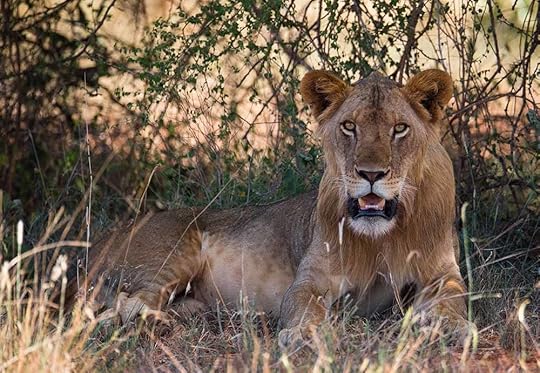
Tsavo region lion.
As the salve trading roads developed through Tsavo, many traders pushed their captives hard across the barren wasteland. When a slave died, they were simply left behind, becoming an ample meal for scavenging predators. Many believed this gave the Tsavo lions an early taste for human flesh, one that would be whet for the incoming British in the late 19th-century.
The Ghost and the Darkness
Soon after Lieutenant Colonel John Henry Patterson arrived to lead the construction of a railroad bridge in 1898, lion attacks ravaged his worker’s camp. Striking in the night, a pair of lions with a seemingly insatiable appetite stalked the builders. Screams could be heard in the dead of night as these ferocious predators pulled men from their tents into the wilderness.
Some accounts state that 135 people were eaten by the two lions that year, but company reports place the official figure closer to around 40. This figure, however, didn’t account for any nearby villagers that may have been killed by the lions, making the true number a mystery.
Patterson the Lion Slayer
Lieutenant Patterson, who had hunted tigers in India, was put in charge of stopping the lion’s massacre. He erected thorn barriers, lit bonfires at night, and enacted curfews, but the attacks only seemed to get worse. The workers grew increasingly superstitious and mutinous. It took Patterson months to kill the lions, and upon their deaths, they discovered both were maneless males, rogues without a pride. At over nine feet long each, they were also abnormally larger than other lions in the era, most likely owed to their ample new source of food.
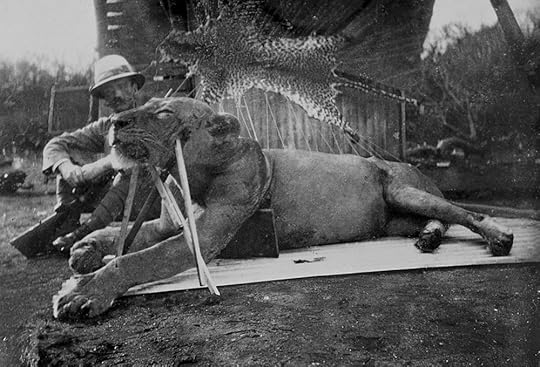
Patterson and one of the man-eaters.
Patterson was immediately proclaimed a hero, restoring faith in his workers and acclaim around the world. The lions were stuffed, eventually making their way to Chicago’s Field Museum of Natural History.
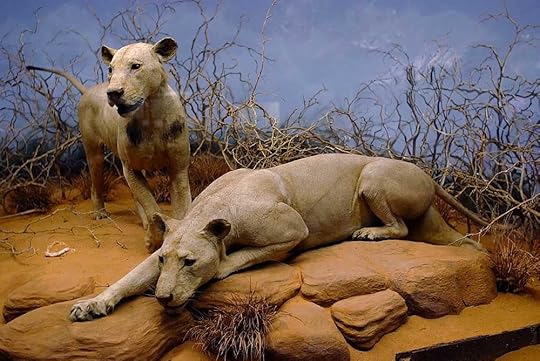
The stuffed Tsavo man-eaters./CC Jeffrey Jung
Modern Study
At the time, much romance and superstition were used to explain the Tsavo man-eaters’ behavior. An incorrigible appetite or taste for human blood was chief among Patterson’s own account of the animals’ reasoning. He surmised that the careless burial practices in the region had meant the lions often scavenged human remains, enticing them to dine on humans.
Since the lions’ remains were preserved, scientists have been able to examine their mouths and discovered that damaged jaws may have accounted for their behavior. With evidence of an abscessed tooth, they believe one of the lions may have had trouble hunting larger prey, and might have been forced to raid the camps for food.
Source: The Savage Tsavo Man-Eaters And The Man Who Stopped Them
CARTOON 05-15-2019
May 14, 2019
How Bruce Springsteen Was Inspired By Boardwalk Fortune Teller Madame Marie
Featured in Ripley's Believe It or Not!

“Did you hear the cops finally busted Madame Marie for tellin’ fortunes better than they do?”—Bruce Springsteen, 4th of July, Asbury Park (Sandy).
It was with the above lyric in Bruce Springsteen and the E Street Band’s 1973 hit, colloquially nicknamed “Sandy,” that Marie Castello became forever immortalized in the rock and roll zeitgeist. Castello is best known as psychic medium Madame Marie, the proprietor of what came to be known among Jersey Shore locals as the Temple of Knowledge for eight decades on the Asbury Park boardwalk.

Born in Asbury Park in 1915, the “Gypsy Queen of the Boardwalk” first got her start in 1932 as a teenage clairvoyant in the midst of the Great Depression, a time when more people than ever wanted to see where their future was headed. Self-professedly possessing the gift since the age of nine, it was at her tiny twelve foot by twelve-foot hut telling fortunes and providing psychic readings to generation-after-generation of shoobies and beach bums alike that Madame Marie first became acquainted with a young Bruce Springsteen.
It was the mid-sixties and the future Boss himself was a seventeen-year-old aspiring guitarist, set up outside of the venerable Madame Marie’s stall. These street performances outside of the Temple of Knowledge led to a friendship between the sibyl and the busking Boss, where Springsteen’s signature folksy reverence for the mystic, intangible wonders of life was no doubt emboldened. According to Springsteen, Madame Marie even prophetically predicted his own future fame within the music industry.
“Back in the day when I was a fixture on the Asbury Park boardwalk, I’d often stop and talk to Madame Marie as she sat on her folding chair outside the Temple of Knowledge. I’d sit across from her on the metal guardrail bordering the beach, and watched as she led the daytrippers into the small back room where she would unlock a few of the mysteries of their future. She always told me mine looked pretty good—she was right.”—Bruce Springsteen.
Bruce Springsteen was not the only celebrity to rub elbows and have palms read by the perennially popular prognosticator. Celebrities on-loan at the nearby Asbury Park Convention Hall who stopped by the oracle’s cabana to get love, life, and tarot card readings include musical megastars such as Elton John, Ray Charles, The Rolling Stones, and KISS, Wizard of Oz star Judy Garland, director Woody Allen and frequent collaborator, actress Diane Keaton, actors Danny DeVito and Matt Dillon, the barrier-breaking Diahann Carroll, golden-age Hollywood stars Perry Como and Vic Damone, and professional wrestling star and New Jersey native Gorilla Monsoon.

Madame Marie would continue to be a regular fixture at her boardwalk stand until her death in 2008 at the age of 93, the longest-running tenant in the Asbury Park Boardwalk’s century-and-a-half history.
Maybe Madame Marie put a spell on Springsteen, because he never forgot her and always stopped by to say hello whenever he was in town. Upon her passing, the Boss would go on to eulogize her before dedicating his July 4th, 2008 performance of 4th of July, Asbury Park (Sandy) to Madame Marie.
“There’s enough mystery lost in the world, we need all the fortune-tellers we can get. So tonight we’re gonna send this one out to Madame Marie.”—Bruce Springsteen.
Today, Asbury Park has reinvented itself as a premier family destination. The shop still stands sentinel, situated on the boardwalk and keeping watch over the waterfront just outside the shadow of the Asbury Park Convention Hall. Covered in psychedelic murals, the Temple of Knowledge stands in the exact same location since Madame Marie first opened its doors in 1932: squarely in front of the Wonder Bar, with Tillie’s wide-smiling face leering from the backstreets of the booth and a block away from the Stone Pony, the venue that helped launch the careers of both Bruce Springsteen and Bon Jovi.

CC John C. Lovell
Though Madame Marie is no longer with us, there is life in death as her visionary business venture remains in the family. Ripleys.com was able to sit down with the third-generation fortune-teller and granddaughter of Madame Marie, Dainzie Castello. Born to run the Temple of Knowledge, Dainzie told us a little more about this unusual, passed-down family tradition. Dainzie, her sister, and their children claim to possess the gift of being a conduit of visions from the third eye. That’s a total of five individuals!
Just a short walk from Asbury Park’s burgeoning, bourgeois hipster district, amid the carnival atmosphere of boardwalk games, the smell of fresh pizza and powdery funnel cake, and the ever-present flock of cackling seagulls dive-bombing for spare french fries, the Temple of Knowledge bares witness to Dainzie’s devotees as they line up outside the wigwam-sized lodge. There, they greet Dainzie with reverence as she carries out her grandmother’s—now her family’s—legacy of soothsaying.
“I tell you a little bit about past, present, and future. Whatever I see.”—Dainzie Castello, granddaughter of Madame Marie.
“He’s a real sweetheart,” Dainzie reveals about Bruce, “a real Jersey guy. He never lost his ties to home. Even when he was walking around the boardwalk, you could feel that energy. He would play his guitar and he would put out the little bucket and people would throw him money. My grandmother used to throw him out because he was a little roughneck. And one day he said, ‘am I going to be successful? Am I going to be something?’ And she said, ‘one day you’re going to be the Boss.’ I think it was just to shut him up, really. Bruce Springsteen made her famous and he feels like she blessed him with that name and made him famous. So they fed off each other. They were very good together.”

So far as Madame Marie’s inclusion in the song is concerned: “It was a surprise. She really got a kick out of it.”
When asked about Madame Marie’s abilities, Dainzie tells us,“She was a life coach when people didn’t know what a life coach was. It’s not occult or witchcraft. It’s nothing like that. It’s a gift. A psychic gift. It’s something that we were born with.”
When it comes to the lives of the individuals she reads, Dainzie tells us that “everybody’s life is interesting.” The augur then told us that the portents for Ripley’s were looking “very good.”
“This pier lights our carnival life forever…”—Bruce Springsteen, 4th of July, Asbury Park (Sandy)
“Sandy,” as the nostalgic love ballad is best known, is a wistful, romanticized look back into the rearview mirror of the endless glory days of youthful summers. Springsteen’s song remains an enduring love note not only to the eponymous Sandy, but it captures the timeless spirit and culture of the boardwalks of the Jersey Shore, which wouldn’t be themselves without quirky characters such as Madame Marie and her everlasting Temple of Knowledge.
Drawn by the mystical energies of Asbury Park, the Ripley’s Believe It or Not! Carnival of Curi-Oddities is headed there to dazzle audiences with feats of skill and daredevilry at the Paramount Theater. From far-fetched feats to biological marvels, this collection of awe-inspiring curi-oddities will spark your imagination, ignite your curiosity, and showcase the truly unbelievable but undeniably true.
By Kris Levin, contributor for Ripleys.com
Kris Levin is a traveling storyteller, professional wrestling referee, and everybody’s favorite nephew. He can be seen internationally on IMPACT Wrestling as their most junior official, #KidRef, and on social media at @RefKrisLevin
Source: How Bruce Springsteen Was Inspired By Boardwalk Fortune Teller Madame Marie
Why Spice Traders Relied On Camel Bladders
Featured in Ripley's Believe It or Not!

The spice trade dominated pre-Christian Europe, with tales of secret and fantastic places exporting flavors and smells that seemed almost magical to the West. In order to transport cardamom, cinnamon, ginger, and pepper out of Asia, however, traders had to pass through the unforgiving deserts of Persia and Arabia.
Beginning in the first millennia B.C., traders in India set out to sell their incense and oils on the backs of camels. Camels were a natural choice of transportation for crossing the desert. Their high heat tolerance, water-conserving bodies, and wide feet carried merchants and their wares with the dependability that no horses could offer.

Though they don’t store water in their humps, camels can drink as much as 32 gallons of water in a short 15 minutes, re-hydrating them enough to survive nearly a week without water. Several facets of the camel’s body give them an edge in the desert. Their humps store energy as fat, they have long eyelashes to guard against sand, and they urinate infrequently.
Though it can expand a bit, the camel’s bladder is relatively small for an animal that can easily drink a few dozen gallons of water in one sitting. Their water-conscious biology expels urinary waste in small amounts, though it is highly concentrated.
When you’re trekking a year’s livelihood worth of spices across the desert for months, you want to ensure that your precious cargo is safe. While pottery and barrels may work for ships, their high weight proved too much for camels. Instead, camel caravans relied on bags and preserved camel bladders to keep their goods safe.

Camel bladders would be removed, cleaned, and sometimes oiled to preserve them. These containers would then be dried in vase-like shapes and filled with spices, essential oils, or even fat for the long journey. They withstood high temperatures, didn’t dry out in the arid wind, and were durable enough to survive the perils of the journey. Once they arrived at their destination, old camel bottles were often turned into vases.
CARTOON 05-14-2019
Ripley Entertainment Inc.'s Blog
- Ripley Entertainment Inc.'s profile
- 52 followers







